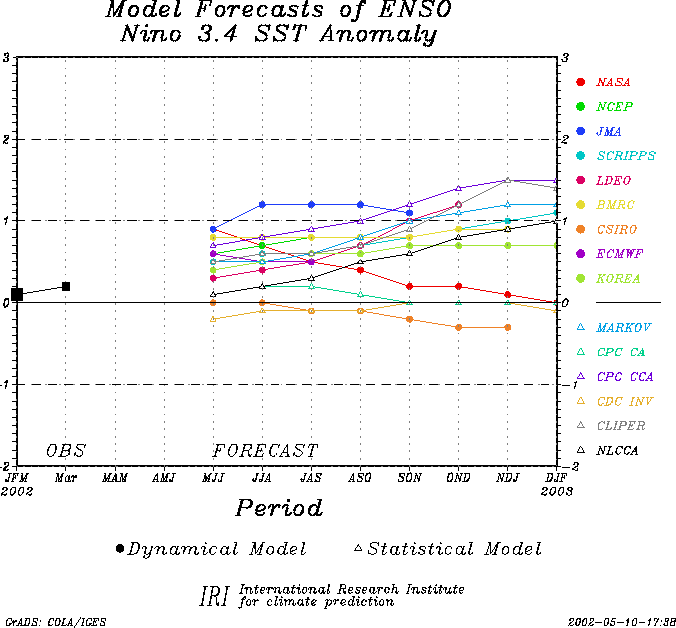|
Summary of ENSO Model Forecasts
16 April, 2002
The set of dynamical and statistical
model forecasts issued during late March and early April shows a
fairly wide range of possible ENSO conditions for the coming 3 to 8
months (May-June-July through December-January-February 2003). More
models are indicating a warming tendency than a neutral outlook, and
none are calling for cold conditions. A sizeable proportion of models
forecast significant warming (e.g., warming to 0.6 degrees C or more
above average in the Nino 3.4 region for the June-July-August
seasonal average). A noticeable fraction are also forecasting ENSO
conditions in the upper half of the neutral category—between 0.0
and 0.5 degrees C above normal. The warmest forecast for the
June-July-August period comes from the dynamical model of the
Japanese Meteorological Agency (1.2 degrees C above normal), and the
coldest one is from the NOAA/CDC linear inverse model, calling for
SST anomalies of -0.1 degrees C. For later in the year, such as
September-October-November or later, ten of the fourteen models that
forecast to that long a lead time suggest El Nino development: the
NCEP coupled, JMA, Scripps, Lamont-Doherty, BMRC, KMA-SNU, CPC
Markov, CPC-CCA, Colorado State CLIPER, and the UBC nonlinear CCA.

FORECAST SST ANOMALIES (deg C) IN
NINO 3.4 REGION
|
Model
|
MJJ
|
JJA
|
JAS
|
ASO
|
SON
|
OND
|
NDJ
|
DJF
|
|
==Dynamical models==
|
|
NASA/NSIPP model
|
0.9
|
0.7
|
0.5
|
0.4
|
0.2
|
0.2
|
0.1
|
0.0
|
|
NCEP Coupled model
|
0.6
|
0.7
|
0.8
|
0.8
|
0.8
|
0.9
|
1.0
|
|
|
Japanese Met. Agcy. model
|
0.9
|
1.2
|
1.2
|
1.2
|
1.1
|
|
|
|
|
Scripps Inst. model
|
0.5
|
0.6
|
0.6
|
0.7
|
0.8
|
0.9
|
1.0
|
1.1
|
|
Lamont-Doherty model
|
0.3
|
0.4
|
0.5
|
0.7
|
1.0
|
1.2
|
|
|
|
BMRC intermed. model
|
0.8
|
0.8
|
0.8
|
0.8
|
0.8
|
0.9
|
0.9
|
|
|
CSIRO model
|
0.0
|
0.0
|
-0.1
|
-0.1
|
-0.2
|
-0.3
|
-0.3
|
|
|
ECMWF model
|
0.6
|
0.5
|
0.5
|
|
|
|
|
|
|
KMA SNU (Korea) model
|
0.4
|
0.5
|
0.6
|
0.6
|
0.7
|
0.7
|
0.7
|
0.7
|
|
Average, dynam. models
|
0.6
|
0.6
|
0.6
|
0.6
|
0.7
|
0.6
|
0.6
|
|
|
|
|
==Statistical models==
|
|
NCEP/CPC Markov model
|
0.5
|
0.5
|
0.6
|
0.8
|
1.0
|
1.1
|
1.2
|
1.2
|
|
NOCC/CDC Linear Inverse
|
-0.2
|
-0.1
|
-0.1
|
-0.1
|
0.0
|
0.0
|
0.0
|
-0.1
|
|
Dool Constructed Analog
|
0.1
|
0.2
|
0.2
|
0.1
|
0.0
|
0.0
|
0.0
|
0.0
|
|
NCEP/CPC Can Cor Anal
|
0.7
|
0.8
|
0.9
|
1.0
|
1.2
|
1.4
|
1.5
|
1.5
|
|
Landsea/Knaff CLIPER
|
0.5
|
0.6
|
0.6
|
0.7
|
0.9
|
1.2
|
1.5
|
1.4
|
|
Univ. BC nonlinear Can Cor
|
0.1
|
0.2
|
0.3
|
0.5
|
0.6
|
0.8
|
0.9
|
1.0
|
|
Average, statistical models
|
0.3
|
0.4
|
0.4
|
0.5
|
0.6
|
0.7
|
0.8
|
0.8
|
|
AVERAGE, ALL MODELS
|
0.4
|
0.5
|
0.5
|
0.6
|
0.6
|
0.7
|
0.7
|
0.8
|
Some notes about the formulation of the
entries in the table above:
=>Only models producing forecasts on
a monthly basis are included. This means that some models whose
forecasts appear in the Experimental Long-Lead Forecast Bulletin
(produced by COLA) do not appear in the table (e.g. the COLA
forecasts).
=>The SST anomaly forecasts are for
the 3-month periods shown, and are for the Nino 3.4 region (120-170W,
5N-5S). Often, the anomalies are provided directly in a graph or a
table by the respective forecasting centers for the Nino 3.4 region.
In some cases, however, they are given for 1-month periods, for
3-month periods that skip some of the periods in the above table,
and/or only for a region (or regions) other than Nino 3.4. In these
cases, the following means are used to obtain the needed anomalies
for the table:
o temporal averaging,
o linear temporal interpolation,
o visual averaging of values on a
contoured map, and
o regional SST anomaly adjustment using
the climatological variances of one region versus that of another.
As an example of the last case, suppose
only the Nino 3 anomaly is provided. The Nino 3.4 anomaly is then
obtained by decreasing the Nino 3 anomaly by the factor defined by
the ratio of the year-to-year variance of Nino 3.4 to the
year-to-year variance of Nino 3 SST, for the 3-month season in
question.
The anomalies shown are those with
respect to the base period used to define the normals, which vary
among the groups producing model forecasts. They have not been
adjusted to anomalies with respect to a common base period.
Discrepancies among the climatological SST resulting from differing
base periods may be as high as a quarter of a degree C in the worst
cases. Forecasters are encouraged to use the standard 1971-2000
period as the base period, or a period not very different from it.
Back
|